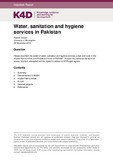Water, Sanitation and Hygiene Services in Pakistan
Abstract
This rapid review examined the extent of water, sanitation and hygiene services in the Khyber Pakhtunkhwa and Punjab Provinces of Pakistan. It analyses the published literature on issues, solutions attempted and the impact in relation to KP/Punjab regions. It finds that access to WASH services varies between two provinces. The Government of KP’s 2017 Health Survey found that 89% of households have access to improved water sources, and 85% have accessed to improved sanitation (Government of KP, 2017). In contrast, according to the Government of the Punjab, access to improved water sources is approximately 94% in the Punjab and access to improved sanitation is 72% (Government of Punjab, 2015). Sanitation service, however, is found to be a gender issue as women and girls face a number of hidden difficulties in accessing sanitation (Ahmed, Miankhel, Kanaganathan & Villeminot, 2015). Menstruation is a social taboo in Pakistan and both WaterAid and the Government of the Punjab are working to increase menstrual hygiene management education in schools to create girl friendly environments and the opportunity for girls to stay in school (WaterAid, 2018; Aman, 2018). Key findings from the report include poor water safety, poor hygiene and poorly sited and constructed pit latrines, as well as poor drainage can lead to drinking water contamination and waterborne diseases even in villages with access to improved water and sanitation, as illustrated by two case studies from KP (Nawab, Esser & Baig, 2017). Drinking water is not often treated, for example, 93.8% of household in the Punjab do not use any water treatment method (Government of Punjab, 2015). In addition to this, community awareness raising and education tools are important to bring about behaviour change, and also to combat beliefs including water being safe to drink if it is clear and does not smell (Shah, Khan, Kanwal & Bernstein, 2016).
Citation
Cooper, R. (2018). Water, sanitation and hygiene services in Pakistan. K4D Helpdesk Report. Brighton, UK: Institute of Development StudiesIs part of series
K4D Helpdesk Report;502Rights holder
© DFID - Crown copyright 2018.Collections
- Pakistan - Other [11]
- K4D [937]

